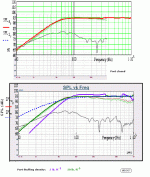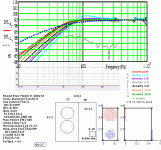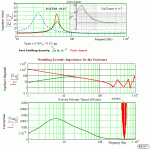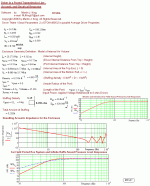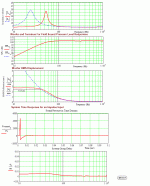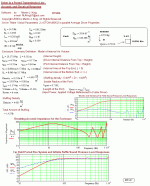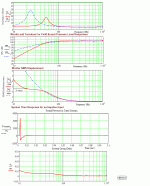Didn't long gone TDL Electronics use something like a variovent in their speakers? HERE'S a link to some TDL catalog pages. I have a large pair of Wharfedale M-148 monitors that have bass ports almost exactly like the TDL TL2 and TL3. The foam in the ports on the M-148s feels like there is some sort of screen or grid behind it to keep it from getting pushed in. I assume the TDLs were the same.
Hi all, I have done a bit of experimental work with aperiodic tuning. The latest incarnation worked well first up. What I can tell you is that it is the easiest and least complex way of obtaining a flat bass response from a small enclosure.
My method is to tune the enclosure as if it were a bass reflex to about 100 hz, and then damp the port to reduce the z peak at resonance. In it's simplest form, the port can be a hole in the underside of the cabinet, with a number of layers of fibre fill laid over the bottom panel. Of course the sides of the enclosure are lined to reduce internal reflections.
I have damped to the point where the z peak was only 1.4 times the rated z. That's going too far. It kills sensitivity and dynamics.
All drivers to date have been higher q models. The one I completed today is 0.8 ^ft, tuned with a 56mm dia port (I plan to tune the box with a duct for comparative purposes) The driver is a Dai-1chi HW-100F-05. Nothing special. Fo 40Hz, Zo 34R Rdc 7R5
No real measurements done yet, just a quick sweep to ensure the z was doing nothing strange.
A test in the garden with some bluesy jazz and walking bass revealed a smooth and mellow tone down low and nice bite in the midrange, which is something else AP seems to provide, but in this case I didn't want. It's to be used to reinforce some OBs.
It's not the ultimate in cab designs, but if it's to be portable or simply compact, is an easy solution and plenty of scope for experimentation.
Geoff.
My method is to tune the enclosure as if it were a bass reflex to about 100 hz, and then damp the port to reduce the z peak at resonance. In it's simplest form, the port can be a hole in the underside of the cabinet, with a number of layers of fibre fill laid over the bottom panel. Of course the sides of the enclosure are lined to reduce internal reflections.
I have damped to the point where the z peak was only 1.4 times the rated z. That's going too far. It kills sensitivity and dynamics.
All drivers to date have been higher q models. The one I completed today is 0.8 ^ft, tuned with a 56mm dia port (I plan to tune the box with a duct for comparative purposes) The driver is a Dai-1chi HW-100F-05. Nothing special. Fo 40Hz, Zo 34R Rdc 7R5
No real measurements done yet, just a quick sweep to ensure the z was doing nothing strange.
A test in the garden with some bluesy jazz and walking bass revealed a smooth and mellow tone down low and nice bite in the midrange, which is something else AP seems to provide, but in this case I didn't want. It's to be used to reinforce some OBs.
It's not the ultimate in cab designs, but if it's to be portable or simply compact, is an easy solution and plenty of scope for experimentation.
Geoff.
Hi,
FYI; I’ve used Dave T: s speaker’s data and definition with one of MJK: s programs in order to find out if it’s possible to simulate an aperiodic port.
MJK: s graphs overlaid on Dave T: s plots fits very good but I must admit there could be a mistake when using damping material with higher densities (up to 20 lb/ft^3) than what MJK: s guaranteed limits is = 1 lb/ft^3 maximum and how limited this damping coefficient function is for accepting other input numbers than recommended.
My simple method was to step the density until the speaker impedance at box resonance lowered to about a comparable value that you have shown us in your plots.
There is a linear proportional behaviour when stepping the densities and in reality this is exactly what you can observe when measuring different stuffing densities in an aperiodic port, especially if the damping material is denser than normal box stuffing.
Nevertheless the plausible result is there even if this increase in density affects the damping coefficient a lot and could as been said; be completely wrong. But who knows?
See the first three plots I’ve made overlaying Dave T: s the MJK: s and then the remaining 4 that are plots of the closed and aperiodic boxes.
b
FYI; I’ve used Dave T: s speaker’s data and definition with one of MJK: s programs in order to find out if it’s possible to simulate an aperiodic port.
MJK: s graphs overlaid on Dave T: s plots fits very good but I must admit there could be a mistake when using damping material with higher densities (up to 20 lb/ft^3) than what MJK: s guaranteed limits is = 1 lb/ft^3 maximum and how limited this damping coefficient function is for accepting other input numbers than recommended.
My simple method was to step the density until the speaker impedance at box resonance lowered to about a comparable value that you have shown us in your plots.
There is a linear proportional behaviour when stepping the densities and in reality this is exactly what you can observe when measuring different stuffing densities in an aperiodic port, especially if the damping material is denser than normal box stuffing.
Nevertheless the plausible result is there even if this increase in density affects the damping coefficient a lot and could as been said; be completely wrong. But who knows?
See the first three plots I’ve made overlaying Dave T: s the MJK: s and then the remaining 4 that are plots of the closed and aperiodic boxes.
b
Attachments
Navin,
The source I think I have found is member SY who is the moderator. Unfortunately, I can not email him directly as I do not have enough posts. Maybe you can.
His details are on
http://www.diyaudio.com/forums/member.php?s=&action=getinfo&userid=3783
I am currently in Pune. You can reach me on 952026131769
Alopa
The source I think I have found is member SY who is the moderator. Unfortunately, I can not email him directly as I do not have enough posts. Maybe you can.
His details are on
http://www.diyaudio.com/forums/member.php?s=&action=getinfo&userid=3783
I am currently in Pune. You can reach me on 952026131769
Alopa
Greets!
Interesting, I thought I made that abundantly clear quite awhile ago in one of these threads and that the only truly aperiodic alignment is a 'perfect' BLH, though you can get 'close enough' with a max flat impedance alignment. Every other 'aperiodic' alignment is just a leaky sealed cab, to quote RonE and others.
GM
Interesting, I thought I made that abundantly clear quite awhile ago in one of these threads and that the only truly aperiodic alignment is a 'perfect' BLH, though you can get 'close enough' with a max flat impedance alignment. Every other 'aperiodic' alignment is just a leaky sealed cab, to quote RonE and others.
GM
Hi GM,
You did point me to the correct definition of "aperiodic" which caused me to go over my findings, and differentiate between TJs ARU and Dynaudios Variovent. (And I thought I thanked you for that)
To use the term "leaky sealed" implies (to me anyway) a poorly built sealed enclosure with a leak that can result in a subsonic resonance and air noise and distortion.
If I overlooked thanking you for your direction in the other thread, I do that now.
Regards,
Geoff.
You did point me to the correct definition of "aperiodic" which caused me to go over my findings, and differentiate between TJs ARU and Dynaudios Variovent. (And I thought I thanked you for that)
To use the term "leaky sealed" implies (to me anyway) a poorly built sealed enclosure with a leak that can result in a subsonic resonance and air noise and distortion.
If I overlooked thanking you for your direction in the other thread, I do that now.
Regards,
Geoff.
GM said:... the only truly aperiodic alignment is a 'perfect' BLH, though you can get 'close enough' with a max flat impedance alignment.
Hi GM
might be a bit OT, but could you please explain (or point to an explanaition) what a max flat impedance alignment is?
thanks,
LC
The car audio community take on AP :
Car Audio:
'An Aperiodic enclosure is one in which the woofer breathes thru a resistive membrane to control it's cone characteristics.
In laymen's terms, it makes a woofer in a tiny enclosure act as if it were in a large, sealed enclosure.
These membranes can be either on the backside of the woofer enclosure, OR, covering the cone of the woofer'
Hi, I would say that the 'car audio community’ uses the concept of AP to cover all existing damping theories, throw them in a sack shaking all into a mishmash then pouring all out on the floor, pick one up, applying them one by one in order to customize a car audio driver into a small space.
Of course if you follow the prescription, there will be a result at the end, but it starts with no predictable control at all.
The interdependence of critical variables are ignored from the very start not denying that if following the instructions, this will lead to a successful result, but certainly the opposite in the end, if not coping the instructions exactly step by step using the recommended dimensions and materials.
In the introduction, the very first three sentences are blatant misconceptions revealing the lack of basic knowledge of this type of applied acoustics.
No, the take on AP is not a good one re explaining aperiodic enclosures; it’s a tweak concept only borrowing the buzzword AP from somewhere.
b
Hi
I used a variovent or aperiodic loaded 12" full range speaker for a few years. It worked ok and gave very extended base. ( I used a large cabinet with a large vent. The speaker worked as I had expected to from the design I had performed.
The only difficulty I found was holding the filling in the variovent rigid. This seemed to be very important in obtaining a tight base.
Don
I used a variovent or aperiodic loaded 12" full range speaker for a few years. It worked ok and gave very extended base. ( I used a large cabinet with a large vent. The speaker worked as I had expected to from the design I had performed.
The only difficulty I found was holding the filling in the variovent rigid. This seemed to be very important in obtaining a tight base.
Don
bjorno said:
Car Audio:
'An Aperiodic enclosure is one in which the woofer breathes thru a resistive membrane to control it's cone characteristics.
In laymen's terms, it makes a woofer in a tiny enclosure act as if it were in a large, sealed enclosure.
These membranes can be either on the backside of the woofer enclosure, OR, covering the cone of the woofer'
Hi, I would say that the 'car audio community’ uses the concept of AP to cover all existing damping theories, throw them in a sack shaking all into a mishmash then pouring all out on the floor, pick one up, applying them one by one in order to customize a car audio driver into a small space.
Of course if you follow the prescription, there will be a result at the end, but it starts with no predictable control at all.
The interdependence of critical variables are ignored from the very start not denying that if following the instructions, this will lead to a successful result, but certainly the opposite in the end, if not coping the instructions exactly step by step using the recommended dimensions and materials.
In the introduction, the very first three sentences are blatant misconceptions revealing the lack of basic knowledge of this type of applied acoustics.
No, the take on AP is not a good one re explaining aperiodic enclosures; it’s a tweak concept only borrowing the buzzword AP from somewhere.
b
I did find their idea of using the smallest 'box' possible an interesting one (for car audio at least). Although as it needs 'venting' into another space it kind of defeats the object. just use ib type drivers instead.
Rob.
lovechild said:Hi GM
might be a bit OT, but could you please explain (or point to an explanaition) what a max flat impedance alignment is?
thanks,
LC
Greets!
See if this helps, beginning here: http://www.diyaudio.com/forums/showthread.php?postid=1100809#post1100809
GM
- Status
- This old topic is closed. If you want to reopen this topic, contact a moderator using the "Report Post" button.
- Home
- Loudspeakers
- Multi-Way
- How about the sealed box with "variovent"?
